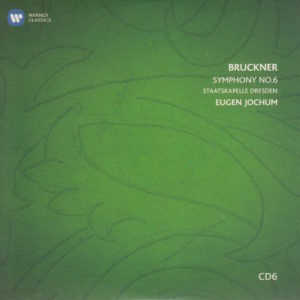 This morning’s conductor of Anton Bruckner’s Symphony No. 6 in A Major (WAB 106) is German-born Eugen Jochum (1902-1987), unarguably one of the most highly respected interpreters of Anton Bruckner’s music who ever lived.
This morning’s conductor of Anton Bruckner’s Symphony No. 6 in A Major (WAB 106) is German-born Eugen Jochum (1902-1987), unarguably one of the most highly respected interpreters of Anton Bruckner’s music who ever lived.
I have two CD box sets conducted by Jochum – this one, on the Warner Classics label (I call it the “Green Box”), and another on the DG label (I call it the “White Box”). I chose to listen to the symphony from the DG set first because the recordings are older. (I figured chronological order was a fair enough delineator.)
The orchestra today, in the “Green Box,” is Staatskapelle Dresden.
To date, I have been privileged to hear 10 performances conducted by Maestro Jochum – five from the “White Box” and five from the “Green Box.”
As I’ve discovered, I prefer one of those box sets over the other.
But I’ll save the subjective stuff for later.
First, the objective stuff.
I first encountered Eugen Jochum (in my 144-day project) on Day 7 (Symphony No. 1, Green Box)
Then again on Day 23 (Symphony No. 2, Green Box).
And again on Day 39 (Symphony No. 3, Green Box).
And again on Day 55 (Symphony No. 4, Green Box).
And, most recently, on Day 71 (Symphony No. 6, Green Box).
Here are the objective aspects of today’s recording:
Bruckner’s Symphony No. 6 in A Major (WAB 106) composed 1879-1881
Eugen Jochum conducts
Jochum used the Nowak edition
Staatskapelle Dresden plays
The symphony clocks in at 56:21
This was recorded in Dresden, Germany, in June of 1978
Jochum was 76 when he conducted it
Bruckner was 57 when he finished composing it
This recording was released on the Warner Classics label
Bruckner wrote his symphonies in four parts. The time breakdown of this one (Symphony No. 6 in A Major, ed. Nowak), from this particular conductor (Jochum) and this particular orchestra (Staatskapelle Dresden) is as follows:
I: Majestoso…………………………………………………………………………………………………….16:11
II: Adagio. Sehr feierlich (Very solemnly)……………………………………………………….18:36
III: Scherzo. Nicht schnell (Not fast) — Trio. Langsam (Slowly)………………………7:58
IV: Finale. Bewegt, doch nicht zu schnell (With motion, but not too fast)……13:35
Total running time: 56:21
Now, the subjective aspects.
My Rating:
Recording quality: 3 (noticeable tape hiss, ambient noises)
Overall musicianship: 4
CD liner notes: 3 (minimal information, one essay)
How does this make me feel: 3
See? This is what I’ve been talking about.
The difference between yesterday’s Eugen Jochum on the DG label and today’s Eugen Jochum on the Warner Classics label is night and day. (Well, maybe not night and day. More like night and twilight.)
This recording comes perilously close to having a somewhat flat sound, kind of like the AM radio sound I mentioned a time or two. Yesterday’s recording on the DG label was flawless. It was rich and deep and complex and distinctive.
I’ve often thought that the space between the notes is often as important as the notes themselves. Obviously, not literally. Without the notes you got nothing. But how they are played, and how they are recorded, makes or breaks the symphony.
Jazz great Miles Davis is quoted as saying, “Don’t play what’s there, play what’s not there.”
What he meant isn’t quite clear (there are various theories). But I think what he means is to – as the Brits say – mind the gap, the space between the notes. Allow them to breathe.
Recordings are that way. Without sufficient space between the notes (and the instruments), the recording lacks depth.
That, plus, the brassiness of the brass instruments makes me feel a little discontented about this recording.
It’s okay. But it’s not “Huzzah!” quality. It’s slightly more than “Meh” quality. But it’s not a recording I can recommended to Bruckner newbies – not when there are so many from which to choose.
